Every day is transformation
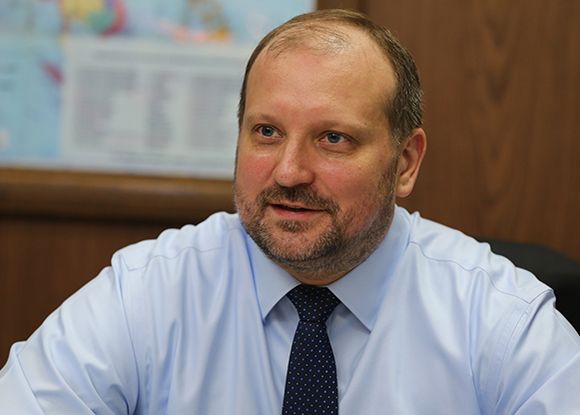
648
27 September 2016
The objective of the current transformation programme for Samruk-Kazyna is to lay the foundation for permanent changes
Adamas Ilkyavichyus, Managing Director for Transformation and Special Projects – might not be the composer, but definitely the conductor of transformation at Samruk-Kazyna. The process of team building and fine-tuning coordination between central and branch transformation teams completed. Now, the main task is to implement all the changes in a timely manner. It is necessary to make sure that business units have started to think and work in new ways.
To be implemented
- How difficult did it seem to transform Samruk-Kazyna in the beginning, and what do you think about it now?
- I have been working in Kazakhstan since 2009, so in 2013, when I joined the Fund, I already had an understanding of what we needed to work on. The Transformation Programme launched in 2014 by the President himself, and it immediately drew public and national attention fr om day one. They expected to see the results ‘here and now’ but that was impossible, because the process of transformation cannot happen overnight. Therefore, in addition to our core business activities on reengineering the national companies, revising strategies, creating efficiency trees and developing IT architecture, we held many meetings with representatives of state bodies and journalists and opinion leaders in order to clarify the objectives and tasks of transformation.
“OUR TASK IS TO INVOLVE ALL EMPLOYEES INTO THIS PROCESS AS MUCH AS POSSIBLE AND TO CONVINCE THEM OF THE NEED FOR CHANGES”
After completing the design of ‘companies of the future’, since the middle of this year, we started to implement projects designed to improve the performance of companies qualitatively. At the same time we decided to separate long-term projects, with implementation periods of one year or more from short-term projects. Among the long-term we may include projects such as the "integrated system of planning," "a new model for procurement process management" or "single capital projects management system." Some of the short-term projects already have the first results. For example, the companies managed to find additional reserves within the scope of the project for "the release of goods and materials". It is an impressive amount of money. In Samruk-Energo the volume of proven reserves amounted to 700 million tenge, in Kazatomprom - 500 million tenge. Automation of business processes in project management will enable companies to manage goods and materials better in the future.
In May this year during the AEF, we presented the book "SK 2020", which reflected the outlook for the benefits of the programme. To date, this forecast is about 1.4 trillion tenge in 2020.
Looking back at what we have done, I can say that we have worked well. At this point, the success of our business and getting the benefits of this volume depends on our ability to implement all transformation projects on schedule and with the use of available human and material resources.
- How did you choose the six national companies, which have become the main objects of the transformation?
- These six companies were selected based on benchmarking conducted in 2014. For example, our companies, including the KMG, KTZ, Samruk-Energo and others demonstrated lower results than their foreign peers did in the effectiveness of the use of investment and return on investment.
The uniqueness of the programme lies in the fact that it covers companies from very different fields of activity. Oil and gas, and the railway industry, electricity, postal and financial services. Based on this, we can specify the transformation for each company. This means that the development of project solutions must take into account the specifics of each company – something that works for the KMG, will not work for the Kazpost. However, the fundamental principles of doing business, such as the presence of an effective corporate governance system, the interests and rights of shareholders, accountability and transparency must be the same everywhere.
- One of the areas of transformation is strengthening the Boards of Directors (BoD) of companies. What do you understand by strengthening the BoDs? What were the weaknesses of the previous BoDs?
BoDs need a mature corporate governance culture in order to fully carry out their functions. Last year we adopted the Samruk-Kazyna Corporate Governance Code, which corresponds to the OECD standards and sets a completely new legal framework for BoDs in the group companies, both in terms of strategic and control functions. BoD is becoming a real partner for business and the company's management.
Therefore, strengthening BoDs primarily means strengthening the role of the BoDs, which should not perform a ‘decorative’ function and become a real effective tool for managing the company. Secondly, we are talking about strengthening the composition of BoDs by bringing strong professional experts with extensive practical experience in the financial, manufacturing, operating and other fields, and not distinguished public figures, as it was before. BoDs consisting of professionals can ensure the right strategic decisions.
The changes that take place today in the Group, carried out in close cooperation with the members of the BoDs of the portfolio companies, which have the necessary set of knowledge and competencies, as well as extensive international experience, which is especially important in the context of growing global competition.
They will play as good as you motivate
- Did you meet with resistance to the transformation policy at the subsidiaries? What kind of issues give cause for concern? How do you solve these problems?
- Resistance is an integral part of any process of change. Most people do not want to part with the usual way of business. Someone not willing to delegate some of his powers to another employee and therefore resists, someone else does not understand the need for ongoing development and learning new skills and thus slows down the process of change.
However, people should be understand that we started the transformation not just to reduce the number of employees. Our task is to involve all employees into this process as much as possible and to convince them of the need for changes. After all, if we want the transformation to succeed, we need a sincere belief that the old way of life is no longer possible. Otherwise, by forcing people to do something, we are faced with the fact that a person begins to work in the old way, as soon as we look away from him.
In the process of changes, people to question their own future: "What will happen to me? How changes affect my work? What happens to the company?" Realizing that the lack of two-way communications is one of the biggest risks for the transformation, we regularly carry out the so-called information days or ‘infodays’ for staff. During these meetings, top management in each national company explains the goals of the work, demonstrates plans and explains in detail the changes that will affect the work of employees. Branch offices also connect through video and audio. Corporate media outlets publish the information about the activities and the responses received to the questions from staff members. We, as the Fund, also try to make this process as transparent as possible for external auditors and call for this all the national companies.
- How do you resolve the problem of traditionally weak communications between national companies and the Fund?
We strive to ensure that the process of implementation of the transformation programme was clear and transparent for all parties involved. First, each of the national companies have its own road map approved by the Fund with dates and amount of work on the transformation. Regular monitoring of works execution. Secondly, quarterly meetings of the Modernization Council at the Fund level with the Fund and Portfolio companies’ management in wh ere they report the work progress, discuss problematic issues and modify the plan of action accordingly. Third, the transformation issues are under constant control of the Prime Minister, who hears CEOs during the meetings of the Transformation Programme Implementation Control Committee.
- Reduction of staff is an inevitable result of the changes of this magnitude. How many employees were laid off at the companies within the framework of the transformation programme? What did the Fund do to support these people?
- As I said, the reductions of working places are not the purpose of the transformation process. They are rather a side and, unfortunately, inevitable effects of reducing unnecessary layers of management, processes automation, focusing on functions that are profitable for company, and the abandonment of support functions such as outsourcing accounting, tax, IT-functions – it all means reductions of jobs.
For example, about 15 percent of employees had been reduced only at the Fund since the beginning of this year. The majority of people who have left were successful professionals. Some of them have continued their careers in international organizations, some in Kazakhstan companies, others somewhere else overseas. I believe that all my former colleagues will certainly find their places.
Regarding manufacturing companies – there are special retraining programmes for workers whose updated duties require new knowledge and skills. In the case of reducing, we provide for the payment of severance benefits. I would also like to note that at the regional levels, the company management is working on these issues closely with local authorities in order to prevent the emergence of social tension.
The Transformation’s Triangle
- "People, processes and technology" – these three components, in your opinion, are the most important in the process of transformation. What technologies have you introduced over the last two years? What was the effect?
- Yes, you are absolutely right. These three components of transformation are inextricably linked with each other. We have implemented a business reengineering ( "processes"); created new organizational structures, we do a lot of job on training people and nurturing the new competencies we need ( "people"). All this should be accompanied by a proper level of automation ("Technology").
In 2014, we conducted an analysis of the automation in the Group, during which it became clear that only about 30 percent of the processes were automated, despite the high level of capital investment. Automation of processes was similar to "patchwork", so loosely speaking: first, we automated accounting, and then bought a separate information system for procurement, and the HR-services work in the third information system. Therefore, in order to get an integrated report on the activity of the enterprise, it was necessary to manually collect data from three different systems!
We started our work on the transformation with reengineering the business - we sorted out business processes and organizational structures and only then automated them with the help of modern information technologies, preferring cloud technologies and service models of software and IT infrastructure.
To achieve the transformation objectives, the level of automation should be at least 70 percent. The gap between what it is now and how it should be, as you can see is large enough. Therefore, in order to optimize costs, we, at the fund level, developed standard automation templates that allow companies to carry out the financial and administrative activities in unified systems. The companies’ task is to adapt these templates to the specifics of their activities. Currently, part of the template solutions were given to the companies, which are working on adaptation and implementation.
In addition, as part of the transformation, we purchase software for several companies at the same time, and it allows us to achieve greater discounts from suppliers. For example, due to the conclusion of a strategic agreement with SAP in December of the last year we were able to save 200 billion tenge on software expenses for a five-year period, from 2015 till 2020. We plan to conclude similar agreements with other suppliers.
This integrated approach to the automation of the companies will make their work more efficient and more transparent, which will bring more benefits for the shareholder represented by the Government, as well as increase the investment attractiveness of the company's assets.
- The range of tasks is enormous. Is it possible to complete the transformation by 2020?
- You are right; we have much work to do. However, despite this, our work plans are scheduled up until 2020, and the active phase will be completed by that time. I believe that there is no alternative to this process. During this period, our job is not just to implement the transformation projects, but also to lay the foundation for continuous improvements - such experience is usual for the world's leading companies, and it is an essential condition for steady growth and prosperity of the Samruk-Kazyna Group in the future.
Adamas Ilkyavichyus, Managing Director for Transformation and Special Projects – might not be the composer, but definitely the conductor of transformation at Samruk-Kazyna. The process of team building and fine-tuning coordination between central and branch transformation teams completed. Now, the main task is to implement all the changes in a timely manner. It is necessary to make sure that business units have started to think and work in new ways.
To be implemented
- How difficult did it seem to transform Samruk-Kazyna in the beginning, and what do you think about it now?
- I have been working in Kazakhstan since 2009, so in 2013, when I joined the Fund, I already had an understanding of what we needed to work on. The Transformation Programme launched in 2014 by the President himself, and it immediately drew public and national attention fr om day one. They expected to see the results ‘here and now’ but that was impossible, because the process of transformation cannot happen overnight. Therefore, in addition to our core business activities on reengineering the national companies, revising strategies, creating efficiency trees and developing IT architecture, we held many meetings with representatives of state bodies and journalists and opinion leaders in order to clarify the objectives and tasks of transformation.
“OUR TASK IS TO INVOLVE ALL EMPLOYEES INTO THIS PROCESS AS MUCH AS POSSIBLE AND TO CONVINCE THEM OF THE NEED FOR CHANGES”
After completing the design of ‘companies of the future’, since the middle of this year, we started to implement projects designed to improve the performance of companies qualitatively. At the same time we decided to separate long-term projects, with implementation periods of one year or more from short-term projects. Among the long-term we may include projects such as the "integrated system of planning," "a new model for procurement process management" or "single capital projects management system." Some of the short-term projects already have the first results. For example, the companies managed to find additional reserves within the scope of the project for "the release of goods and materials". It is an impressive amount of money. In Samruk-Energo the volume of proven reserves amounted to 700 million tenge, in Kazatomprom - 500 million tenge. Automation of business processes in project management will enable companies to manage goods and materials better in the future.
In May this year during the AEF, we presented the book "SK 2020", which reflected the outlook for the benefits of the programme. To date, this forecast is about 1.4 trillion tenge in 2020.
Looking back at what we have done, I can say that we have worked well. At this point, the success of our business and getting the benefits of this volume depends on our ability to implement all transformation projects on schedule and with the use of available human and material resources.
- How did you choose the six national companies, which have become the main objects of the transformation?
- These six companies were selected based on benchmarking conducted in 2014. For example, our companies, including the KMG, KTZ, Samruk-Energo and others demonstrated lower results than their foreign peers did in the effectiveness of the use of investment and return on investment.
The uniqueness of the programme lies in the fact that it covers companies from very different fields of activity. Oil and gas, and the railway industry, electricity, postal and financial services. Based on this, we can specify the transformation for each company. This means that the development of project solutions must take into account the specifics of each company – something that works for the KMG, will not work for the Kazpost. However, the fundamental principles of doing business, such as the presence of an effective corporate governance system, the interests and rights of shareholders, accountability and transparency must be the same everywhere.
- One of the areas of transformation is strengthening the Boards of Directors (BoD) of companies. What do you understand by strengthening the BoDs? What were the weaknesses of the previous BoDs?
BoDs need a mature corporate governance culture in order to fully carry out their functions. Last year we adopted the Samruk-Kazyna Corporate Governance Code, which corresponds to the OECD standards and sets a completely new legal framework for BoDs in the group companies, both in terms of strategic and control functions. BoD is becoming a real partner for business and the company's management.
Therefore, strengthening BoDs primarily means strengthening the role of the BoDs, which should not perform a ‘decorative’ function and become a real effective tool for managing the company. Secondly, we are talking about strengthening the composition of BoDs by bringing strong professional experts with extensive practical experience in the financial, manufacturing, operating and other fields, and not distinguished public figures, as it was before. BoDs consisting of professionals can ensure the right strategic decisions.
The changes that take place today in the Group, carried out in close cooperation with the members of the BoDs of the portfolio companies, which have the necessary set of knowledge and competencies, as well as extensive international experience, which is especially important in the context of growing global competition.
They will play as good as you motivate
- Did you meet with resistance to the transformation policy at the subsidiaries? What kind of issues give cause for concern? How do you solve these problems?
- Resistance is an integral part of any process of change. Most people do not want to part with the usual way of business. Someone not willing to delegate some of his powers to another employee and therefore resists, someone else does not understand the need for ongoing development and learning new skills and thus slows down the process of change.
However, people should be understand that we started the transformation not just to reduce the number of employees. Our task is to involve all employees into this process as much as possible and to convince them of the need for changes. After all, if we want the transformation to succeed, we need a sincere belief that the old way of life is no longer possible. Otherwise, by forcing people to do something, we are faced with the fact that a person begins to work in the old way, as soon as we look away from him.
In the process of changes, people to question their own future: "What will happen to me? How changes affect my work? What happens to the company?" Realizing that the lack of two-way communications is one of the biggest risks for the transformation, we regularly carry out the so-called information days or ‘infodays’ for staff. During these meetings, top management in each national company explains the goals of the work, demonstrates plans and explains in detail the changes that will affect the work of employees. Branch offices also connect through video and audio. Corporate media outlets publish the information about the activities and the responses received to the questions from staff members. We, as the Fund, also try to make this process as transparent as possible for external auditors and call for this all the national companies.
- How do you resolve the problem of traditionally weak communications between national companies and the Fund?
We strive to ensure that the process of implementation of the transformation programme was clear and transparent for all parties involved. First, each of the national companies have its own road map approved by the Fund with dates and amount of work on the transformation. Regular monitoring of works execution. Secondly, quarterly meetings of the Modernization Council at the Fund level with the Fund and Portfolio companies’ management in wh ere they report the work progress, discuss problematic issues and modify the plan of action accordingly. Third, the transformation issues are under constant control of the Prime Minister, who hears CEOs during the meetings of the Transformation Programme Implementation Control Committee.
- Reduction of staff is an inevitable result of the changes of this magnitude. How many employees were laid off at the companies within the framework of the transformation programme? What did the Fund do to support these people?
- As I said, the reductions of working places are not the purpose of the transformation process. They are rather a side and, unfortunately, inevitable effects of reducing unnecessary layers of management, processes automation, focusing on functions that are profitable for company, and the abandonment of support functions such as outsourcing accounting, tax, IT-functions – it all means reductions of jobs.
For example, about 15 percent of employees had been reduced only at the Fund since the beginning of this year. The majority of people who have left were successful professionals. Some of them have continued their careers in international organizations, some in Kazakhstan companies, others somewhere else overseas. I believe that all my former colleagues will certainly find their places.
Regarding manufacturing companies – there are special retraining programmes for workers whose updated duties require new knowledge and skills. In the case of reducing, we provide for the payment of severance benefits. I would also like to note that at the regional levels, the company management is working on these issues closely with local authorities in order to prevent the emergence of social tension.
The Transformation’s Triangle
- "People, processes and technology" – these three components, in your opinion, are the most important in the process of transformation. What technologies have you introduced over the last two years? What was the effect?
- Yes, you are absolutely right. These three components of transformation are inextricably linked with each other. We have implemented a business reengineering ( "processes"); created new organizational structures, we do a lot of job on training people and nurturing the new competencies we need ( "people"). All this should be accompanied by a proper level of automation ("Technology").
In 2014, we conducted an analysis of the automation in the Group, during which it became clear that only about 30 percent of the processes were automated, despite the high level of capital investment. Automation of processes was similar to "patchwork", so loosely speaking: first, we automated accounting, and then bought a separate information system for procurement, and the HR-services work in the third information system. Therefore, in order to get an integrated report on the activity of the enterprise, it was necessary to manually collect data from three different systems!
We started our work on the transformation with reengineering the business - we sorted out business processes and organizational structures and only then automated them with the help of modern information technologies, preferring cloud technologies and service models of software and IT infrastructure.
To achieve the transformation objectives, the level of automation should be at least 70 percent. The gap between what it is now and how it should be, as you can see is large enough. Therefore, in order to optimize costs, we, at the fund level, developed standard automation templates that allow companies to carry out the financial and administrative activities in unified systems. The companies’ task is to adapt these templates to the specifics of their activities. Currently, part of the template solutions were given to the companies, which are working on adaptation and implementation.
In addition, as part of the transformation, we purchase software for several companies at the same time, and it allows us to achieve greater discounts from suppliers. For example, due to the conclusion of a strategic agreement with SAP in December of the last year we were able to save 200 billion tenge on software expenses for a five-year period, from 2015 till 2020. We plan to conclude similar agreements with other suppliers.
This integrated approach to the automation of the companies will make their work more efficient and more transparent, which will bring more benefits for the shareholder represented by the Government, as well as increase the investment attractiveness of the company's assets.
- The range of tasks is enormous. Is it possible to complete the transformation by 2020?
- You are right; we have much work to do. However, despite this, our work plans are scheduled up until 2020, and the active phase will be completed by that time. I believe that there is no alternative to this process. During this period, our job is not just to implement the transformation projects, but also to lay the foundation for continuous improvements - such experience is usual for the world's leading companies, and it is an essential condition for steady growth and prosperity of the Samruk-Kazyna Group in the future.
Рекомендуем
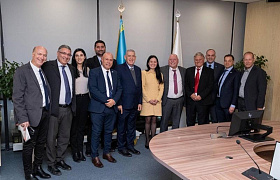
{{ $t('messages.news1') }}
The Management of Samruk-Kazyna JSC Met with a Delegation from the Sta...
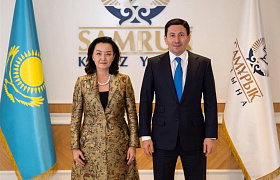
{{ $t('messages.news1') }}
Nurlan Zhakupov, Chairman of the Management Board of Samruk-Kazyna JSC...
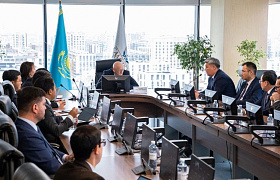
{{ $t('messages.news1') }}
Gas Industry Development: QazaqGaz to Report on Results and Projects
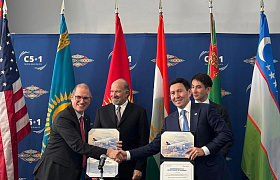
{{ $t('messages.news1') }}
A Number of Documents Signed by the Samruk-Kazyna Group during the Vis...


